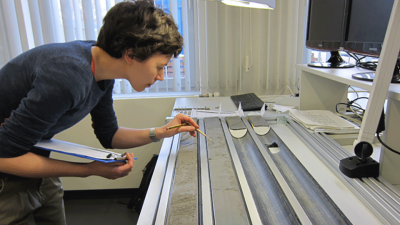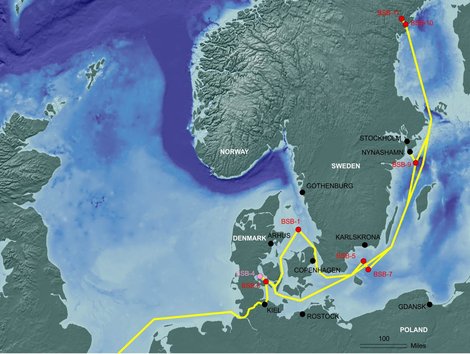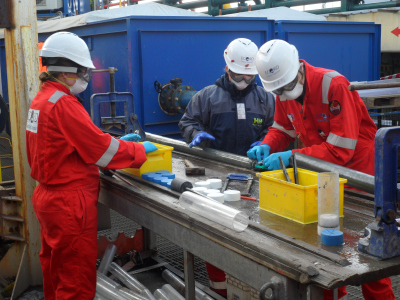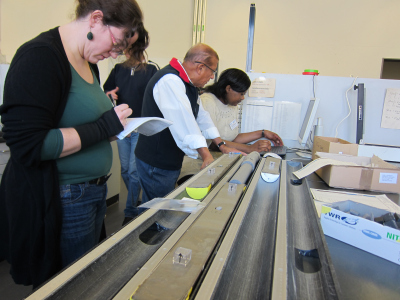Die Inhalte dieser Seite sind leider nicht auf Deutsch verfügbar.
Seitenpfad:
- Startseite
- Entdecken
- Pressemitteilungen
- Pressemitteilungen 2014
- Deciphering a Complex History
Deciphering a Complex History
The labs of the Bremen Core Repository in the MARUM building have been buzzing in recent weeks. 31 scientists working in daily shifts from early morning to late evening have been describing, scanning, analysing, and sampling sediment cores retrieved from the Kattegat, Little Belt, and the central and northern parts of the Baltic Sea. 60 metres of core are being analysed per day, and about 30,000 samples will have been taken by the time the science party finish their work on February 20th. A group of 20 IODP scientists, technicians and curators plus 16 student helpers assist the international team in their research.
“Until now we have only had a fragmentary understanding of the glacial and post-glacial history of the Baltic region”, says Dr. Thomas Andrén, from Södertörn University, Sweden, one of two expedition chief scientists: “Some of the sediment layers we have collected show extreme detail. In cores with sediment younger than ~10,000 years we can see that up to 5 mm of new sediment accumulated annually. This is a rapid rate of change that makes it possible for us to partly draw a new picture of the dynamic climate response and the environmental history in the Baltic Sea Basin during and after the last ice age – and possibly further back in time to the previous warm age that ended about 114,000 years ago known as the Eemian.”
One of the deepest holes was drilled in the Little Belt, a narrow strait in Danish waters. Reaching 203 metres below the seafloor, the core tells the story of the early stage of the Baltic Ice Lake, an immense body of fresh water that originated when the Scandinavian ice sheet started to melt during the final phase of the last ice age. Between ~16,000 and 11,700 years ago, enormous amounts of fresh water were discharged from the Baltic Ice Lake into the northern Atlantic Ocean. During a period of only one or two years, as the lake finally drained through the south central Swedish lowland, about 7,800 cubic kilometres of freshwater were released into the Atlantic Ocean - causing an interruption in the warm North Atlantic deep-water current which today maintains the relatively mild climate of northwestern Europe.
At Landsort Deep, a drill site to the southeast of Stockholm, in water depths of up to 437 metres, the IODP scientists retrieved a core that contains laminated layers. These layers of light and dark clays, and an organic-rich mud known as gyttja, are evidence that the water at the bottom of the Baltic Sea was oxygen free from about 8,000 years ago well into recent times. “At this site we took about 1,800 samples to study the diatom flora”, says Dr. Andrén. “These unicellular small plants will help us to learn more about past variations in salinity and sea-surface temperatures”.
Ice-sheet history, fresh-water periods, salt-water intrusions and brackish phases, as well as oxygenated versus anoxic episodes: all these events are archived in the cores from the Baltic expedition. However, throughout these times, life persisted – not only in the water but also deep beneath the seabed. “We want to understand how microbial life functions in this so-called deep biosphere”, says co-chief scientist Prof. Bo Barker Jørgensen from Aarhus University, Denmark: “Are microorganisms that presently live in the deep sediments remnants of past fresh-water or sea-water communities? Or are they selected by the sub-seafloor environment and have evolved unique capacities to subsist under extremely nutrient-poor conditions?” In order to answer questions like these, Prof. Jørgensen has coordinated the work of 14 research groups in Europe, the United States, China, and Japan, which had already been provided with samples during the offshore phase of the expedition last year. “Microbiologists have to work on fresh samples”, Prof. Jørgensen points out. “We collected about 5,000 samples on board the expedition vessel. Once they have been analysed we will, for the first time, know which forms of life exist in the deep biosphere of the Baltic Sea and the specific role these microorganisms play in the great bioreactor of the seabed.
The Baltic Sea expedition was organized and carried out by the European Consortium for Ocean Research Drilling (ECORD). ECORD is the European branch of the International Ocean Discovery Program (IODP), which conducts worldwide expeditions and is led by Japan, the USA, and a consortium of 18 European countries (plus Canada). The IODP consortium also includes associates from Australia, New Zealand, India, China, South Korea and Brazil, therefore is one of the major marine research programmes in the world. Since 2004 ECORD, has completed four similar coring expeditions in the Arctic, the Atlantic, and two in the Pacific Ocean.
More information / photos / interviews:
Albert Gerdes
ECORD Science Operator
MARUM – Bremen/Germany
Public Relations
Phone: +49 – 421 – 65540
www.marum.de
www.eso.ecord.org
“Until now we have only had a fragmentary understanding of the glacial and post-glacial history of the Baltic region”, says Dr. Thomas Andrén, from Södertörn University, Sweden, one of two expedition chief scientists: “Some of the sediment layers we have collected show extreme detail. In cores with sediment younger than ~10,000 years we can see that up to 5 mm of new sediment accumulated annually. This is a rapid rate of change that makes it possible for us to partly draw a new picture of the dynamic climate response and the environmental history in the Baltic Sea Basin during and after the last ice age – and possibly further back in time to the previous warm age that ended about 114,000 years ago known as the Eemian.”
One of the deepest holes was drilled in the Little Belt, a narrow strait in Danish waters. Reaching 203 metres below the seafloor, the core tells the story of the early stage of the Baltic Ice Lake, an immense body of fresh water that originated when the Scandinavian ice sheet started to melt during the final phase of the last ice age. Between ~16,000 and 11,700 years ago, enormous amounts of fresh water were discharged from the Baltic Ice Lake into the northern Atlantic Ocean. During a period of only one or two years, as the lake finally drained through the south central Swedish lowland, about 7,800 cubic kilometres of freshwater were released into the Atlantic Ocean - causing an interruption in the warm North Atlantic deep-water current which today maintains the relatively mild climate of northwestern Europe.
At Landsort Deep, a drill site to the southeast of Stockholm, in water depths of up to 437 metres, the IODP scientists retrieved a core that contains laminated layers. These layers of light and dark clays, and an organic-rich mud known as gyttja, are evidence that the water at the bottom of the Baltic Sea was oxygen free from about 8,000 years ago well into recent times. “At this site we took about 1,800 samples to study the diatom flora”, says Dr. Andrén. “These unicellular small plants will help us to learn more about past variations in salinity and sea-surface temperatures”.
Ice-sheet history, fresh-water periods, salt-water intrusions and brackish phases, as well as oxygenated versus anoxic episodes: all these events are archived in the cores from the Baltic expedition. However, throughout these times, life persisted – not only in the water but also deep beneath the seabed. “We want to understand how microbial life functions in this so-called deep biosphere”, says co-chief scientist Prof. Bo Barker Jørgensen from Aarhus University, Denmark: “Are microorganisms that presently live in the deep sediments remnants of past fresh-water or sea-water communities? Or are they selected by the sub-seafloor environment and have evolved unique capacities to subsist under extremely nutrient-poor conditions?” In order to answer questions like these, Prof. Jørgensen has coordinated the work of 14 research groups in Europe, the United States, China, and Japan, which had already been provided with samples during the offshore phase of the expedition last year. “Microbiologists have to work on fresh samples”, Prof. Jørgensen points out. “We collected about 5,000 samples on board the expedition vessel. Once they have been analysed we will, for the first time, know which forms of life exist in the deep biosphere of the Baltic Sea and the specific role these microorganisms play in the great bioreactor of the seabed.
The Baltic Sea expedition was organized and carried out by the European Consortium for Ocean Research Drilling (ECORD). ECORD is the European branch of the International Ocean Discovery Program (IODP), which conducts worldwide expeditions and is led by Japan, the USA, and a consortium of 18 European countries (plus Canada). The IODP consortium also includes associates from Australia, New Zealand, India, China, South Korea and Brazil, therefore is one of the major marine research programmes in the world. Since 2004 ECORD, has completed four similar coring expeditions in the Arctic, the Atlantic, and two in the Pacific Ocean.
More information / photos / interviews:
Albert Gerdes
ECORD Science Operator
MARUM – Bremen/Germany
Public Relations
Phone: +49 – 421 – 65540
www.marum.de
www.eso.ecord.org






